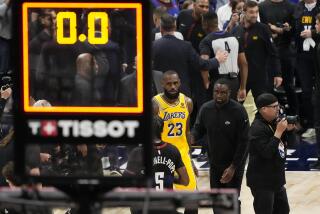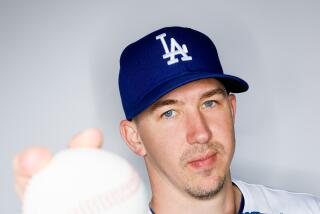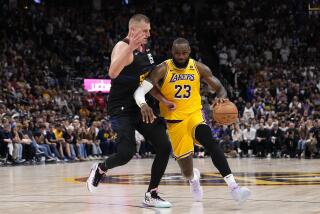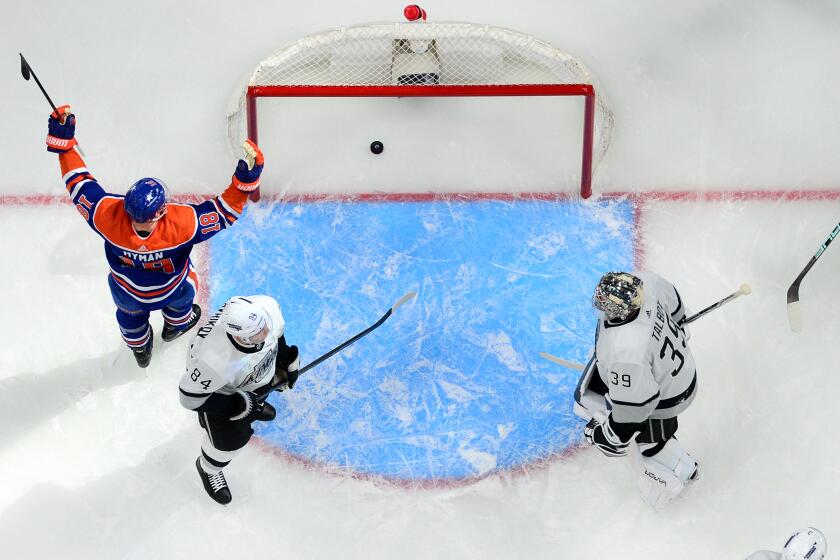NBA Bounces to an Edgy Hip-Hop Beat
The face of professional basketball no longer wears Magic Johnson’s familiar smile. It no longer has Michael Jordan’s classic elegance.
Today, the game has a hipper, edgier persona. Tattoos and baggy shorts, a thumping beat.
“It goes hand in hand with where we’re from,” Laker forward Lamar Odom says. “Guys who come into the league, they’re the hip-hop generation.”
Players are only part of the cultural shift. The National Basketball Assn. has sought to boost its popularity among young fans by playing rap music at games and promoting street-inspired fashion such as throwback jerseys.
But though hip-hop can be an effective marketing tool, those who follow the business of basketball say the NBA is walking a tightrope.
The league’s image has been tarnished by the recent melee between players and fans at an arena in Auburn Hills, Mich. The association with hip-hop similarly plays into concerns about a growing disconnect between the NBA and a portion of its audience. The head of a grass-roots fan group says that in the minds of some middle-aged ticket buyers, the music has helped perpetuate the notion of a “thug league.”
With Christmas Day bringing one of the marquee games of the young season -- Shaquille O’Neal and his new team, the Miami Heat, in Los Angeles to play the Lakers -- marketing experts and sociologists say the NBA must take care in pursuing two very different generations of fans.
“How do you create an environment where you entice young people without alienating your core customers?” asked Artemisia Apostolopoulou, a Bowling Green State University professor who has studied the phenomenon. “The real question for the NBA is, how can they take advantage of the economic power of hip-hop without having the negative connotations?”
To understand where the league is headed, it is helpful to look back.
The game had grown moribund in the 1970s until the arrival of Johnson and Larry Bird. They not only reignited the rivalry between the Lakers and Boston Celtics but also set the NBA on a marketing path that showcased individual players over teams.
Jordan was the logical extension of that strategy, an extraordinary talent and equally savvy at presenting himself to corporate America. The league more than doubled its franchise values to $265 million over a decade and saw annual revenue approach about $3 billion, according to the Sports Business Journal.
The challenge came when Jordan retired and television ratings declined.
“The replacement parts came out of the hip-hop generation,” said Jim Kahler, marketing director for the Cleveland Cavaliers from 1991 to 2002. “We were looking at more tattoos, a different dress code.”
This was the first generation of players to grow up with hip-hop, a cultural movement that started in New York during the late 1960s and early ‘70s, eventually flourishing with its own sound, language and fashions.
Rap music has been the most visible component and -- like rock ‘n’ roll decades earlier -- at times divisive. Gangsta rap, in particular, features violent images and derogatory language toward women.
On court, the new wave of players brought a defiant attitude.
“It’s the way they carry themselves,” said Todd Boyd, a USC critical studies professor who wrote “Young, Black, Rich and Famous,” a book about hip-hop and the NBA. “Guys from impoverished backgrounds who, once they make the league and start making money, say, ‘Look, I’m not interested in changing who I am. I’m not going to participate in this charade you’ve set up.’ ”
Instead of Jordan in a meticulously tailored suit, fans got Allen Iverson in sweats and a cap worn sideways, talented and rebellious.
To some degree, the league had no say in this change. Clipper forward Elton Brand echoed Odom’s assessment when he said: “A lot of the players love [hip-hop]. They’re immersed in it.”
The culture’s influence was immediately apparent if only because players are so exposed, no baseball caps or football helmets to hide their cornrows, no sleeves to cover tattooed shoulders.
The association between basketball and hip-hop grew even stronger when NBA sponsors began making use of rap in their promotions. Consider the case of Jay-Z, who signed a sneaker deal with Reebok and is also among a group of investors that owns the New Jersey Nets.
The rapper is a marketing director’s dream, connecting with millions of young fans who listen to his music. He can also be problematic among older fans, given that his lyrics have been called misogynistic and, three years ago, he was sentenced to probation for stabbing a record producer.
“Obviously, a lot of people have been distraught about the relationship between the NBA and hip-hop,” said Boyd, the USC professor.
So it should be no surprise that the league has taken a nuanced approach toward this partnership.
In 2000, Commissioner David Stern publicly reprimanded the Philadelphia 76ers’ Iverson for recording a rap song that included lyrics derogatory toward women and gays. At the same time, the NBA recognized the marketing value of the medium.
Research suggests that using rappers as endorsers can be particularly effective in reaching the 12- to 24-year-old demographic, said Apostolopoulou, the Bowling Green professor. She pointed out that rap music has crossed racial boundaries, drawing fans among blacks, whites and Latinos.
So the NBA has carefully incorporated hip-hop. That includes playing the music in arenas and signing deals with apparel manufacturers such as FUBU and D’Funkd. The group Nappy Roots is currently performing as part of the NBA’s “Rhythm ‘n Rims” promotional tour.
Other relatively tame hip-hop acts such as LL Cool J, Mary J. Blige and OutKast have performed with the likes of Elton John and Michael McDonald at recent All-Star games.
“We’re always trying to pick the right music, trying to associate with the right people,” said Gregg Winik, executive vice president of NBA Entertainment. “We know we’re constantly being judged by things like that.”
The league executive acknowledged there is inherent risk: Some people hear a heavy beat, the spoken words, and immediately think gangsta rap.
“I think it’s worse than that,” Winik said. “I think once you see a picture [of a rap artist], there are certain segments of the media and certain segments of the public that draw conclusions.”
This tension surfaced after last month’s altercation involving the Indiana Pacers and Detroit Pistons, when players charged into the stands and fans pelted them with drinks and other objects. The brawl touched a chord with fans across the nation, said Robert Hutcherson, founder of Sports Fans of America Assn., a group claiming to have 850,000 members registered through its website.
“When you go to NBA games, it’s dominated by hip-hop,” Hutcherson said. “Basically, the perception we’ve gotten from our membership is that, with the NBA, it’s a thug league.”
This sentiment resonated through the media. Shaun Powell, writing for Newsday, called the fight “an extension of the hip-hop culture [the players] embrace, which promotes and encourages anger, violence, selfishness, bling-bling, excess, the exploitation of women and showboating.”
Washington Post columnist Michael Wilbon, sensing a disconnect between fans and players, wrote of hip-hop: “It is a life based on getting ‘respect’ at any cost, including going into the stands and administering a beat-down if somebody ‘disrespects’ you.”
But, with the Pacers and Pistons scheduled for a Christmas rematch, others have come forward in defense of the league and the music.
“Gangsta rap gives off a negative image but that’s only part of hip-hop,” said Brand, of the Clippers. “There are various artists who don’t curse. They don’t talk about violence. They’re not derogatory to women.”
Even some of the more controversial forms of rap are misinterpreted, Boyd said.
“If you understand hip-hop, you know that individuals are commenting on what they’ve seen growing up in impoverished neighborhoods,” the USC professor said. “It’s really describing ghetto America stories that need to be heard. Rappers are like reporters.”
Boyd sees the controversy surrounding hip-hop as largely generational and exacerbated by an aging media that he describes as “a lot of middle-aged white and black guys who are troubled by hip-hop.”
To some degree, this clash extends to corporate America, experts said. Two NBA sponsors -- the International Dairy Foods Assn. and Nestle -- did not return calls for this article.
Kahler, the former team executive who now teaches sports business at Arizona State, said current stars such as Iverson clearly do not connect with marketers the way, for example, Jordan did.
Yet experts insist the NBA would be foolish to turn away. Dean Bonham, whose Denver-based company, the Bonham Group, serves as a marketing consultant to several NBA teams, explained that the risk of making 40-plus fans uncomfortable is worth the upside.
“We know hip-hop is this generation’s music and its style,” Bonham said. “Hip-hop carries with it the opportunity to impact purchase decisions by perhaps the most affluent group of young people in this country’s history.”
The theory is, all those kids listening to OutKast and Mos Def could grow up to be the next generation of season-ticket holders.
“It’s almost like you’re double-dipping,” said Larry McCarthy, a sports management professor at Seton Hall University. “The players are into the music and the kids are into the players. It’s more than sports. It’s a musical relationship.”
It also plays into another of the NBA’s business strategies. With more and more players coming from Europe, South America, Africa and Asia, the league has been aggressively promoting its game in foreign markets.
Most recently, this effort has focused on reaching potential millions of fans in China through Houston Rocket center Yao Ming. Winik said that when the NBA recently staged an exhibition game in Beijing, there was some question about what music to play.
“They wanted the dance teams, the loud music,” he said. “And if we had the right hip-hop dance performance, that’s what they wanted.”
The NBA certainly faces challenges in the near future, a compendium of issues that include not only generational differences but player behavior and style of play, outside observers say.
But so far, despite some grumblings from fans and the media, experts give the league high marks.
Last season, overall attendance set a record at 21,855,125 and the average attendance for regular-season games was at its highest since 1997-98, the end of the Jordan era.
Television ratings for the 2004 NBA Finals between the Lakers and Pistons also showed in increase over previous seasons.
If the Michigan incident -- which resulted in criminal charges against players and fans -- threatened to derail this momentum, experts said Stern acted wisely by quickly suspending the players involved.
The penalty was particularly harsh -- a full season -- for Pacer forward Ron Artest, who recently produced an album and used post-brawl interviews to promote it.
Looking at the long term, Kahler compared the situation to debates he has with his kids over what kind of music gets played at home.
“Hip-hop should be part of the overall marketing play for the NBA, but you have to find the right mix,” he said. “If you go too hard in any one area, you’re probably going to offend someone.”
More to Read
Get our high school sports newsletter
Prep Rally is devoted to the SoCal high school sports experience, bringing you scores, stories and a behind-the-scenes look at what makes prep sports so popular.
You may occasionally receive promotional content from the Los Angeles Times.







